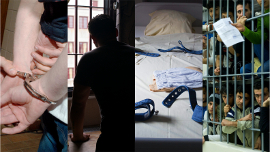The report takes note of the positive developments observed since the previous visit of the Committee as regards combating police ill-treatment. The majority of persons met by the delegation stated they had been treated correctly by the police. Progress had also been noted concerning the recording of trauma injuries observed on detainees by the doctor in charge of police detention facilities in the Bucharest Region, and the reporting of these findings to the competent authorities. Nevertheless, material conditions in police detention facilities – which hold detainees for several months - remain mediocre, particularly as regards overcrowding, disrepair, insalubrity and insufficient access to natural light and ventilation. Concrete recommendations are made by the Committee on this subject.
In their response, the Romanian authorities refer to the zero tolerance policy towards police ill-treatment and provide detailed information on the training activities of police officers in the human rights field. As regards material conditions in police detention facilities, the Romanian authorities consider that a transfer of responsibility for these establishments to the prison administration is still unrealistic.
Regarding the situation in prisons, numerous credible allegations consistent with physical ill-treatment (punches, including with reinforced gloves, kicks with the knee and feet and blows with a truncheon) were received by the delegation. They were mainly inflicted on prisoners under a maximum security regime (“RMS”) and in the closed regime units of Arad and Oradea prisons by members of the intervention group (wearing balaclavas or masks). Medical evidence compatible with the allegations made was found in a certain number of prisoners' medical files in these two establishments. As regards material conditions in prisons, the report notes an overall high-level of overcrowding, with barely 2m² of living space per person in Târgşor Women’s Prison; these conditions were further aggravated by the fact that prisoners generally spent 20 to 22 hours a day in their cells. Furthermore, the report contains recommendations to reinforce the numbers of prison and health-care staff in the establishments visited and to offer work and/or socio-educational activities to prisoners under RMS and closed regimes.
In their response, the Romanian authorities provide detailed information regarding the management and professional training of members of the intervention groups, as well as on improvements made to material conditions and on the reinforcement of prison and health-care staff in the establishments visited by the CPT.
As regards psychiatric establishments, the report notes the satisfactory material conditions in the Bucharest Neuropsychiatric Centre for Recovery and Rehabilitation. On the other hand, the patients at the Săpoca psychiatric hospital generally only had 2-3m² of living space in numerous units, and a certain number of them had to share a bed with other patients. The CPT also stresses the need to develop a structured multidisciplinary approach amongst everyone involved in care/treatment (psychiatrists, psychologists, specialised teachers, occupational therapists and physiotherapists) and to draw up an individualised treatment plan for each patient/resident.
In their response, the Romanian authorities refer to improvements in material conditions and reinforcement of staff at the Săpoca psychiatric hospital.
The CPT's report and the response of the Romanian Government are available on the Committee's website: http://www.cpt.coe.int. (French only)
Executive summary of the report (PDF) (French only)



